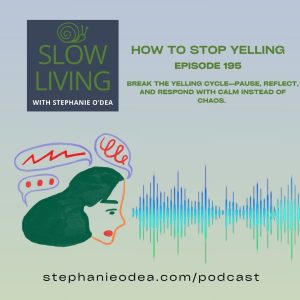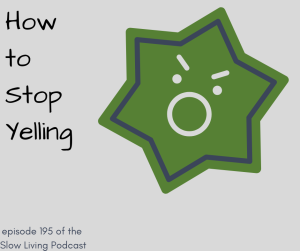How to Stop Yelling: A Slow Living Approach to Emotional Regulation
Do you ever find yourself yelling—and then instantly regretting it?
You’re not alone.
One of the most common things I hear from coaching clients, especially busy moms and caretakers, is this: “I didn’t want to yell, but I snapped. And I hate how it made me feel.”
In today’s fast-paced world, yelling has become a knee-jerk reaction for so many of us—especially when we’re overwhelmed, exhausted, or emotionally tapped out. But here’s the truth: yelling is rarely about what’s happening in the moment.
Instead, it’s often the result of unprocessed emotions, internalized stress, and old patterns that no longer serve us.
And the good news?
You are not broken.
And you can learn how to stop yelling—even if you grew up in a yelling household.
Why Do We Yell?
Yelling is often a symptom, not the root issue.
We yell when we’re pushed to our edge—when fear, anxiety, stress, or helplessness rise up faster than we can manage. It can feel like a release, but it often causes damage: to our relationships, to our self-esteem, and to the emotional tone of our homes.
In one of my coaching sessions, a client shared a heartbreaking story from her childhood. She had a habit of knocking over her glass of milk at the dinner table. And every time, her mother would yell. So what did she do? She stopped drinking milk altogether—just to avoid the reaction.
And that stuck with me.
Because yelling might feel temporary to the person doing it, but to the person receiving it? It lingers.
What Comes Out of You When You’re Squeezed?
There’s a Buddhist teaching I love that says:
“When you squeeze a lemon, lemon juice comes out.
When you squeeze an orange, orange juice comes out.
But when life squeezes you—what comes out?”
Is it anger? Fear? Frustration?
Or is it calm, grounded presence?
The truth is, whatever comes out of us under pressure is a reflection of what’s already inside.
That’s why practicing emotional regulation, self-awareness, and intentional living is so important—especially if you want to stop yelling.
How to Stop Yelling: 5 Slow Living Strategies That Work
Here are five slow, mindful strategies to help you stop yelling—and start responding with purpose.
1. Identify Your Triggers
Start paying attention to the moments that set you off. Is it clutter when you walk in the door? Morning chaos before school? Feeling interrupted during your quiet time?
Awareness is the first step toward change.
2. Create a Pattern Interrupt
A pattern interrupt is a conscious pause—a disruption to your normal reaction loop. Before you yell, give yourself a moment to do something different.
– Take a breath.
– Step into another room.
– Sip water.
– Repeat a calming mantra.
– Count to five.
The goal isn’t perfection—it’s a pause.
3. Journal Your Feelings
Journaling is one of the simplest and most effective tools for emotional regulation. It helps you recognize patterns, process old wounds, and parent yourself gently through big feelings.
Try this prompt:
What emotions are underneath my yelling? What am I really needing in those moments?
4. Plan for Triggering Moments
If you know walking into a messy house triggers you, don’t go inside right away.
– Park a block away and take a few deep breaths.
– Go to the gym first.
– Put on a calming playlist or guided meditation.
You’re allowed to protect your peace.
5. Ask for Help
If you’ve tried everything and still feel like you’re stuck, that’s okay. There is no shame in needing support.
Talk to your doctor.
Find a therapist.
Reach out for coaching.
I have room in my coaching roster and would be honored to help you walk through this process. You are not meant to do this alone.
You Are Not Destined to Repeat What You Grew Up With
If you grew up in a home where yelling was the norm, it’s easy to feel like you’re doomed to repeat the same cycle. But that’s not true.
You have the power to choose a new pattern.
You can break generational cycles.
You can create a calm, safe environment for your family—and yourself.
It starts by slowing down, paying attention, and choosing differently—one moment at a time.
Want More Support?
If this topic resonated with you, here are a few podcast episodes that go deeper:
– Episode 8: Dealing with Overwhelm in Uncertain Times
– Episode 27: Creating Stability
– Episode 33: Healing Childhood Trauma
– Episode 57: Protecting Your Energy
– Episode 71: Self-Loathing
And stay tuned—I’m about to begin live coaching on the podcast in upcoming episodes, where you’ll hear firsthand how these tools work in real life.
Final Thoughts
You are the adult in the room.
You are allowed to slow down.
You are allowed to change.
You are not broken.
And yelling doesn’t have to be part of your story anymore.
If you’d like help navigating this, I’m here. Email me anytime. I’m a real person—and I will write back.
lots of love, and please take care. xoox steph



